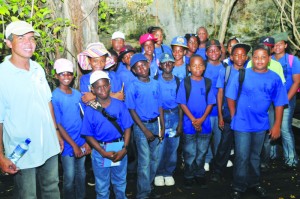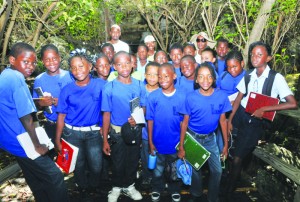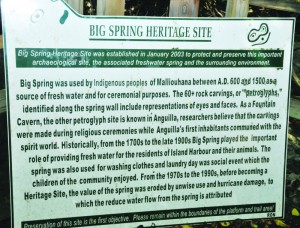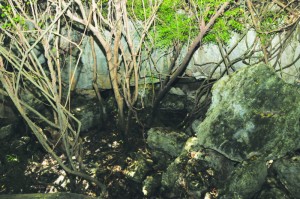
A Social Studies lesson at the Adrian T. Hazell Primary School resulted in over forty grade six students, accompanied by Teachers Juline Hughes and Michael Skellekie, visiting at least two of the Amerindian sites in Anguilla.
“The children are visiting the different sites in Anguilla where the Arawaks settled and they are trying to find out what were their reasons for settling in these areas,” Ms Hughes explained, as the children clamoured down the steps of theBig SpringatIslandHarbour.

Mr. Skellekie, leading a separate group of the sixth grade students, said: “This trip is really to inform them about some of the ways of life of the Arawaks who settled in Anguilla thousands of years ago. We have come to let them learn about some aspects of the culture of these early inhabitants, and to check out the petroglyphs, the markings on the rocks and what this area was used for. The trip is in relation to Social Studies in which the students are learning about the Arawaks and the Caribs – the Amerindians generally.”

The touring party from the school was led by Tour Guide at the Anguilla National Trust,Janeczka Richardson, who said in part: “After the Big Spring I will be taking them to Shoal Bay to see where the Fountain Cavern is, and then we will head to the National Trust. There I will show them the zemis and other artifacts, allow them to touch the exhibits and see photographs of the Fountain Cavern.”
She went on: “I think these tours are very important, giving the children an opportunity to learn about their ancestral background. Most of them do not know what happened in the past, so it is good to link them to where they came from and maybe they can appreciate where they are now.”

One male student, Joshua Davis, of Blowing Point,read a write-up he had prepared which stated in part: “The Big Spring was used by the early inhabitants of Anguilla between AD 600-1500 as a fresh water supply and for ceremonial purposes. The rock carvings identified along the spring represent faces and eyes… Researchers believe that the carvings were made during religious ceremonies…From the 1700s to the late 1900s the Big Spring played the important role of providing fresh water for the residents of Island Harbour and their animals. The spring was also used for washing clothes …and later became a heritage site…”
Joshua and the rest of the visiting student body appeared to have gained a considerable amount of knowledge from the trip, and have something exciting to talk about in their Social Studies class.








